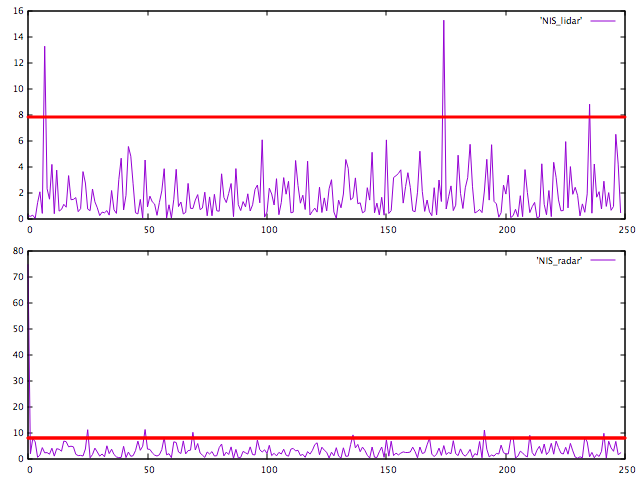Self-Driving Car Engineer Nanodegree Program
In this project utilize an Unscented Kalman Filter to estimate the state of a moving object of interest with noisy lidar and radar measurements. Passing the project requires obtaining RMSE values that are lower that the tolerance outlined in the project reburic.
This project involves the Term 2 Simulator which can be downloaded here
This repository includes two files that can be used to set up and intall uWebSocketIO for either Linux or Mac systems. For windows you can use either Docker, VMware, or even Windows 10 Bash on Ubuntu to install uWebSocketIO. Please see this concept in the classroom for the required version and installation scripts.
Once the install for uWebSocketIO is complete, the main program can be built and ran by doing the following from the project top directory.
- mkdir build
- cd build
- cmake ..
- make
- ./UnscentedKF
Note that the programs that need to be written to accomplish the project are src/ukf.cpp, src/ukf.h, tools.cpp, and tools.h
The program main.cpp has already been filled out, but feel free to modify it.
Here is the main protcol that main.cpp uses for uWebSocketIO in communicating with the simulator.
INPUT: values provided by the simulator to the c++ program
["sensor_measurement"] => the measurment that the simulator observed (either lidar or radar)
OUTPUT: values provided by the c++ program to the simulator
["estimate_x"] <= kalman filter estimated position x ["estimate_y"] <= kalman filter estimated position y ["rmse_x"] ["rmse_y"] ["rmse_vx"] ["rmse_vy"]
- cmake >= v3.5
- make >= v4.1
- gcc/g++ >= v5.4
- Clone this repo.
- Make a build directory:
mkdir build && cd build - Compile:
cmake .. && make - Run it:
./UnscentedKF path/to/input.txt path/to/output.txt. You can find some sample inputs in 'data/'.- eg.
./UnscentedKF ../data/obj_pose-laser-radar-synthetic-input.txt
- eg.
We've purposefully kept editor configuration files out of this repo in order to keep it as simple and environment agnostic as possible. However, we recommend using the following settings:
- indent using spaces
- set tab width to 2 spaces (keeps the matrices in source code aligned)
Please stick to Google's C++ style guide as much as possible.
This is optional!
If you'd like to generate your own radar and lidar data, see the utilities repo for Matlab scripts that can generate additional data.
This information is only accessible by people who are already enrolled in Term 2 of CarND. If you are enrolled, see the project page for instructions and the project rubric.
I did some tests for investigating optimal value of YAW and A params. In the table below results of my tests. In case when A and YAW = 0.5 the RMSE has smallest value.
| Params A/YAW | 30 | 0.1 | 0.3 | 0.28 | 0.48 | 0.5 | 0.51/0.5 |
|---|---|---|---|---|---|---|---|
| X | 0.096 | 0.1250 | 0.063 | 0.0645 | 0.0611 | 0.0612 | 0.0613 |
| Y | 0.096 | 0.1352 | 0.091 | 0.093 | 0.0862 | 0.086 | 0.0858 |
| VX | 0.866 | 0.417 | 0.33 | 0.34 | 0.3304 | 0.3302 | 0.33011 |
| VY | 0.968 | 0.3164 | 0.22 | 0.2287 | 0.2139 | 0.2135 | 0.2134 |
For visualising the NIS values I implemented the GNUplot library.
A/YAW = 30
A/YAW = 0.5

